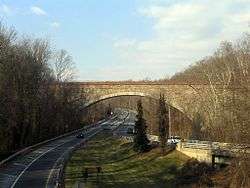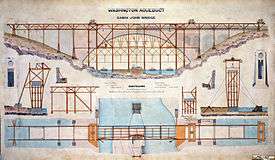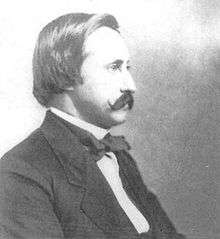Union Arch Bridge
The Union Arch Bridge, also called the "Cabin John Bridge", is a historic masonry structure in Cabin John, Maryland. It was designed as part of the Washington Aqueduct. The bridge construction began in 1857 and was completed in 1864. The roadway surface was added later. The bridge was designed by Alfred Landon Rives, and built by the United States Army Corps of Engineers under the direction of Lieutenant Montgomery C. Meigs.[2][3]
Union Arch Bridge | |
 Union Arch Bridge in 2008. The Cabin John Parkway is seen running underneath the bridge. | |
| Location | Cabin John, Maryland |
|---|---|
| Coordinates | 38°58′22.28″N 77°8′52.69″W |
| Built | 1857–1864 |
| Architect | Meigs, Montgomery C. |
| NRHP reference No. | 73000932 [1] |
| Added to NRHP | February 28, 1973 |
The Union Arch Bridge was designated as a Historic National Civil Engineering Landmark by the American Society of Civil Engineers in 1972 and was listed in the National Register of Historic Places in 1973.
Bridge design
The bridge, with an overall length of 450 ft (140 m) and width of 20 ft (6.1 m), is constructed of Massachusetts granite and red sandstone quarried at the nearby Seneca Quarry, and rises 101 ft (31 m) above Cabin John Creek. The main arch span is 220 ft (67 m) long and rises 57 feet 3 inches (17.45 m).[4] The bridge has an internal spandrel wall structure that contains nine additional smaller arches, which are concealed from view by exterior stone sidewalls.[5] At the time of its construction in 1864, the main span was the longest single-span masonry arch in the world.[6] It retained that distinction until the opening of the 218-foot (66 m) span of the Pont Adolphe Bridge in Luxembourg in 1903.[7] Previously, that honour had gone to the Grosvenor Bridge which crosses the River Dee in Chester, England and which was opened by the thirteen-year-old Princess Victoria (five years before becoming Queen) in October 1832.[6] Visually, the similarities between the Union Arch Bridge and the Grosvenor Bridge are remarkable.[6]
Controversy
The naming of the bridge has been somewhat confused, related to its completion during the Civil War.
Union Arch inscription


While the bridge was being designed and constructed, it was referred to as "Union Arch", "Bridge No. 4" or "Cabin John Bridge" in drawings and government correspondence.[8] The latter two names, however, do not appear in any of the stone carvings that were eventually placed on the bridge. In 1861, as the bridge was nearing completion, the Army drew up initial plans for inscription of commemorative stone tablets to be installed on the bridge. Meigs, who had been promoted to the rank of Captain, issued an order in March 1861 for a tablet on the east bridge abutment. The text was to consist of a title, "Union Bridge," and the names of the principal designers, namely Meigs and Assistant Engineer Alfred L. Rives. By the time the war began, however, Rives had joined the Confederate Army. The final tablet design was modified with the title "Union Arch" and "Alfred L. Rives" was replaced with "Esto Perpetua" ("Let it last forever.").[3][9]:51
Several publications have referred to the "Union Arch" of the Washington Aqueduct,[10] but others refer to the structure as the Cabin John Bridge.[11]
Jefferson Davis inscription

The bridge design process had begun in 1853, during the administration of President Franklin Pierce and the Secretary of War, Jefferson Davis. Captain Meigs' 1861 order also called for a tablet on the west bridge abutment, with the title, "Washington Aqueduct" and listing the political leaders that were in office both at the start of the project and at its completion (i.e., Pierce and Davis; President Abraham Lincoln and Secretary of War Simon Cameron). By 1862, however, Davis had left the Union to become President of the Confederate States of America. There was resentment among some members of Congress about the inscription of Davis' name on the bridge, and this led to an order that his name be removed from the tablet. The Department of the Interior, which was managing the aqueduct at that time, ordered the removal of the inscription.[9]:50
In 1908, President Theodore Roosevelt was asked by various constituents to restore Davis' name to the tablet. Roosevelt ordered the restoration.[9]:51
Twentieth century naming confusion
Some additional confusion over the bridge name arose when the Capital Beltway was constructed in the early 1960s, and the nearby Beltway bridge over the Potomac River was also called the "Cabin John Bridge." However, in 1969 the Beltway bridge was formally named the "American Legion Memorial Bridge."
Historic designations
The Union Arch Bridge was designated as a Historic National Civil Engineering Landmark by the American Society of Civil Engineers in 1972[12] and was listed in the National Register of Historic Places in 1973.[13] Both designations refer to the bridge as the "Cabin John Aqueduct."
Current operation
The bridge continues to support the Washington Aqueduct, as well as a roadway, MacArthur Boulevard. Traffic is narrowed to one lane with traffic signals controlling traffic in either direction. A concrete barrier along the south side creates a separated pedestrian walkway across the bridge. Metal fencing on both sides prevents pedestrians and objects from falling. Signs remind road maintenance crews not to salt the roadway in winter months.
The U.S. Army Corps of Engineers completed a renovation of the bridge in 2001.[14]
See also
References
- "National Register Information System". National Register of Historic Places. National Park Service. 2010-07-10. Listed as "Cabin John Aqueduct."
- Library of Congress. Prints and Photographs Division. Washington, D.C. "Historic American Engineering Record (HAER) Collection: Record No. MD-53." Labeled as "Cabin John Aqueduct Bridge." Record originally prepared by National Park Service, 1987.
- Kelly, John (2010-04-21). "Md. bridge history includes breach that couldn't be spanned". Washington Post.
- Gasparini, Dario A.; Simmons, David A. (March–April 2010). "Cabin John Bridge: Role of Alfred L. Rives, C.E." (PDF). Journal of Performance of Constructed Facilities. 24 (2): 188–203. doi:10.1061/(ASCE)CF.1943-5509.0000080.
- Maryland State Highway Administration. Baltimore, MD (1995). "Historic Highway Bridges in Maryland: 1631-1960: Historic Context Report." Chapter 4, "Stone Arch Bridges: Other Significant Stone Arch Bridges." pp. 58-59. October 1995.
- "The Grosvenor Bridge, Chester". A Virtual Stroll Around the Walls of Chester. Black & White Picture Place. Retrieved 2008-07-09.
- Hopkins, H. J. (1970). A Span of Bridges: An Illustrated History. New York: Praeger Publishers. pp. 96. ISBN 0-7153-4804-3.
- "Message from the President of the United States to the Two Houses of Congress: Report of Operations on the Washington Aqueduct," p. 577 (Washington, D.C.: Government Printing Office, 1861).
- Ways, Harry C. (1996). The Washington Aqueduct: 1852-1992. Baltimore, MD: U.S. Army Corps of Engineers, Baltimore District.
- For example, Francis T. Miller and Robert S. Lanier, "The Photographic History of the Civil War in Ten Volumes," p. 95. (New York: The Review of Reviews Co., 1911.)
- For example, Harvey W. Crew, William B. Webb and John Wooldridge, "Centennial History of the City of Washington, D.C.," p. 49 (Dayton, Ohio: United Brethren Publishing House, 1892).
- American Society of Civil Engineers. Reston, VA. "Designated Historic Civil Engineering Landmarks." Archived 2007-03-21 at the Wayback Machine Labeled as "Cabin John Aqueduct." Accessed February 2, 2008.
- "National Register of Historic Places". National Park Service. February 28, 1973. NRHP No. 73000932. Cite journal requires
|journal=(help)
Note: this NRHP designation is listed as "Cabin John Aqueduct" and refers to the bridge. There is a separate NRHP designation for Washington Aqueduct which refers to the entire aqueduct system from Great Falls, Maryland to Washington, D.C. - U.S. Army Corps of Engineers, Baltimore, MD."Constellation" (Newsletter), Vol. 21, No. 12. Page 5. December 2001.
Further reading
- Chick, H.M. (1934). History and construction of the aqueduct leading to McMillan Park, Washington, D.C. (Thesis). College Park, MD: University of Maryland. pp. 14–16. ARCV 72-115.41. Records of Phi Mu, Special Collections, University of Maryland Libraries.
External links
| Wikimedia Commons has media related to Union Arch Bridge. |
- Historic American Engineering Record (HAER) No. MD-53, "Cabin John Aqueduct Bridge, MacArthur Boulevard, spanning Cabin John Creek at Parkway, Cabin John, Montgomery County, MD", 10 photos, 4 color transparencies, 4 data pages, 3 photo caption pages
- Historic American Buildings Survey (HABS) No. MD-180, "Cabin John Bridge, Cabin John, Montgomery County, MD", 5 photos, 2 data pages
- Cabin John Aqueduct, Montgomery County, Inventory No.: M: 35-37, including photo in 2003, at Maryland Historical Trust website
- American Society of Civil Engineers - Union Arch Bridge
- Union Arch Bridge at Structurae

